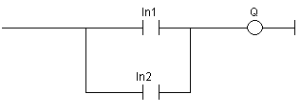![]()
Inputs
|
Input |
Data Type |
Range |
Unit |
Default |
Description |
|---|---|---|---|---|---|
|
IN1 |
BOOL |
|
|
|
First Boolean input. |
|
IN2 |
BOOL |
|
|
|
Second Boolean input. |
Outputs
|
Output |
Data Type |
Range |
Unit |
Description |
|---|---|---|---|---|
|
Q |
BOOL |
|
|
Boolean OR of all inputs. |
Truth Table
|
IN1 |
IN2 |
Q |
|---|---|---|
|
0 |
0 |
0 |
|
0 |
1 |
1 |
|
1 |
0 |
1 |
|
1 |
1 |
1 |
Remarks
None
FBD Language
- In the FBD
 "Function block diagram"
A function block diagram describes a function between input variables and output variables. A function is described as a set of elementary blocks language, the block may have up to 32 inputs.
"Function block diagram"
A function block diagram describes a function between input variables and output variables. A function is described as a set of elementary blocks language, the block may have up to 32 inputs. - The block is called ">=1".
- The block can have a maximum of 32 inputs.
FFLD Language
- In the FFLD language, an OR operation is represented by contacts in parallel.
Example: Parallel contacts:
IL Language
- In IL
 "Instruction list"
This is a low-level language and resembles assembly language, the OR instruction performs a logical OR between the current result and the operand.
"Instruction list"
This is a low-level language and resembles assembly language, the OR instruction performs a logical OR between the current result and the operand. - The current result must be Boolean.
- The ORN instruction performs an OR between the current result and the Boolean negation of the operand.
Op1: FFLD IN1
OR IN2
ST Q (* Q is equal to: IN1 OR IN2 *)
Op2: FFLD IN1
ORN IN2
ST Q (* Q is equal to: IN1 OR (NOT IN2) *)
ST Language
Q := IN1 OR IN2;
Q := IN1 OR IN2 OR IN3;
See Also








